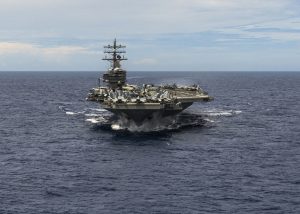On the surface, there are few enough commonalities between the Obama and Trump administrations. Just below the surface, though, they share at least one major strategic imperative: addressing the increasing challenge that China poses to American foreign and security policy goals, especially in the Asia-Pacific region. So, whether Donald Trump is re-elected in November, or Obama’s former vice president Joe Biden takes over, the U.S. will continue to make it a strategic priority to contest Chinese power on the western edge of the Pacific. And though the two men’s views of diplomacy and the place of military force differ vastly, in either case a significant part of that task will fall upon the American military.
But the pandemic and associated economic crisis have played havoc with American public finances. In the early months, the U.S. spent enormous amounts to support businesses and individuals through the early lockdowns. And while additional stimulus may or may not happen, the long-term fiscal toll of the pandemic is likely to be massive. With the U.S. national debt — already high before the pandemic began — rising both as outlays increase and tax revenues fall, the U.S. is likely to find itself tightening its belt in the very near future regardless of the election’s outcome.
There may or may not be a genuine rationale for cutting expenditure — the U.S. can borrow money at very low rates at the moment — and there is a genuine debate over whether such high debt levels are actually damaging. But deficit hawks have demonstrated that they hold significant leverage over federal spending, especially when Democrats hold the White House and Republicans hold at least one house of Congress. So it is a fair surmise that, while it may not happen until the pandemic recedes, budget cuts are coming. And the military, which now accounts for more than half of discretionary spending, is unlikely to be exempted.
If well-managed, a budget cut does not necessarily mean a devastating loss of capability. The extraordinary amount of money appropriated to the Pentagon since 9/11 has not always been spent efficiently or effectively. Nor has that expenditure prevented American military personnel from being asked to do much more with less, with serious consequences. Logically, then, a pared down budget would be accompanied by a streamlined set of missions.
Unfortunately, a considered process of reducing workload and making interlocking efficiencies seems highly unlikely. Partly that is due to the extraordinary list of missions expected of the world’s superpower military, with no certainty what might prove to be crucial in future, and the extraordinary expense of being prepared for all of them.
Domestic politics, however, cannot be removed from the analysis. Consider the driving force the last time significant cuts to the Pentagon budget occurred: a dispute between a Democratic president and Senate, and a Republican House of Representatives, over federal spending and borrowing in 2011. What came from that was an across-the-board cut determined in percentage terms, intentionally designed to be unpalatable in order to nudge negotiators to a better solution. But there was simply too much daylight between the constituencies to find a compromise, so the unpalatable backstop kicked in. The intervening years have not exactly seen a decline in partisanship.
What does this mean for American strategy in Asia? Here we come back to the fact that China policy is a (rare) area of semi-alignment in American foreign policy. As a result of the broad agreement that the U.S. needs to remain engaged in order to maintain leverage over its emerging rival, some aspects of the American presence in the Asia-Pacific are likely to be shielded from the brunt of cuts. That might well include the maintenance of American military facilities in Japan and South Korea and high-profile systems (like the THAAD missile defense system deployed in South Korea) used in theater.
In turn, that means that cuts are likely to fall on big-ticket procurement and modernization programs. But cuts to those areas are also incredibly fraught. Take, for instance, the Zumwalt–class destroyers. Cost growth and disputes over their mission reduced the purchase order from 32 to 7 and eventually down to just three. The U.S. Navy decided to station all three in the Pacific, but in the process of reducing the order, the economies of scale for their bespoke ammunition no longer worked, so the Indo-Pacific Command has three extremely expensive ships which cannot use their primary armament. And program cancellation can result in enormous contractual penalties.
Can the U.S. defense establishment find a way to effectively carry out its missions in the Asia-Pacific even with less funding? Given time and clarity on what those missions are, certainly. But regardless of who is taking the oath of office on the Capitol steps next January, the chaos of U.S. domestic politics is unlikely to abate any time soon. And foreign policy is usually at the mercy of domestic politics, rather than the other way around.

































